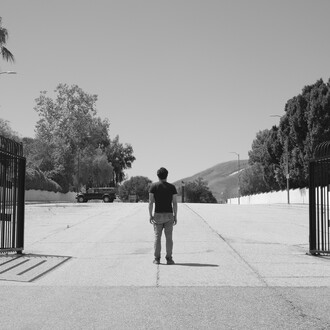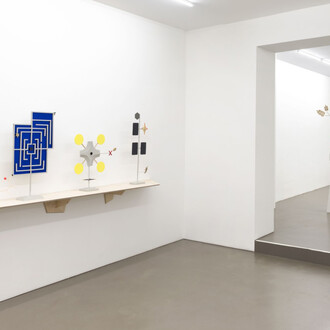Galerie Max Hetzler, Berlin, is pleased to present the group exhibition Break point, featuring works by Darren Almond, Matthew Barney, Elmgreen & Dragset, Barry Flanagan, Günther Förg, Katharina Grosse, Mark Grotjahn, Friedrich Kunath, Jake Longstreth, Eddie Martinez, Rinus Van de Velde and Grace Weaver, at Potsdamer Straße 77-87.
Titled Break point, referring to the pivotal moment in tennis when a returning player is one point from winning the current game, the exhibition takes the relationship between sports and art as its thematic focal point. Since antiquity, these two fields have been complimentary in achieving the perfect balance between the physical and spiritual realms. The exhibited works reflect this duality on the shared notions of discipline and practice, breakthrough and surrender, physical strain and artistic expression. In exploring these parallels, Break Point gestures towards a universal connectedness between corporeality and transcendence.
In Tennis academy, 2025, Jake Longstreth (b. 1977) stages a dialogue between the linear geometry of man-made tennis courts and the organic topography of the Los Angeles skyline. The palm trees and courts, both synonymous with the region, become symbols embedded within the manufactured mythos of the ‘California Dream’. While Longstreth draws equivalence between the tennis court and the landscape, Friedrich Kunath (b. 1974) sets a stark contrast between an abundant seaside paradise and the industrial lines of a clay court, in I know I need a small vacation, 2025.
An entanglement between sport and its cultural staging is present in the painting Gazzetta dello sport LXXII, 2006, one of four large-format works from a series by Günther Förg (1952–2013). In this composition, Förg overlays his signature grid motif across the freely arranged pink pages of the renowned Italian sports daily newspaper, after which the work is titled. Serving as both surface and subject, La gazzetta dello sport was once the most coveted paper in Italy, signifying the connection between sports and its wider environment of entertainment and popular culture.
In Mandala #15, 2021, by Eddie Martinez (b. 1977), the motif of the tennis ball transcends its secular form. It emerges as a portal, which the artist incorporates into the peripheral lane of an orbit built from gestural marks and fragmented shapes. The Mandala, a historically symmetrical and ordered avatar of spiritual guidance in Buddhist ritual, here transmutes into a sphere of controlled chaos.
In contrast to Martinez’s seemingly spontaneous forms, Untitled (Tomato butterfly 55.64), 2023, by Mark Grotjahn (b. 1968), presents a taut visual language. The tightly calibrated pencil lines of chromatic greens and reds radiate with a centrifugal energy, a dynamic that seems to emanate outward and pull inward simultaneously. Darren Almond’s (b.1971) photographic series Baseline (Star chart), 2025, continues his exploration of the limits of space and the transience of time. From the magnified practice wall of the Nadal Tennis Academy in Manacor, the insignificance of the human being within the universe and our centuries-long fascination with the sublime infinity of the cosmos is brought to the fore.
This similitude to quantum forces continues in Katharina Grosse’s (b. 1961) large-scale painting Untitled, 2023. Dominated by yellows, reds and purples, the artist’s saturated pigments surge across the canvas plane horizontally, evoking the kinetic release of a body or object set in motion.
Across the three sculptures in the exhibition, sport becomes a psychological stage for universal human qualities: endurance, fragility, hope and balance. In Large boxing hare on anvil, 1984, Barry Flanagan (1941–2009) juxtaposes the hare, an animal famed for its agility and wit, with the weight of a heavy blacksmithing tool, creating tension between stillness and motion. The white patinated bronze sculpture, Flo, 2023, by Elmgreen & Dragset (b. 1961 and 1969), depicts an adolescent boy in a tennis outfit, with head bowed, lips pursed, and eyes lowered towards his timidly clutched trophy. With a defeated expression, he invites us to reconsider the narratives of triumph and sacrifice. In Patriot, 2024, Matthew Barney (b. 1967) traces the negative space between colliding football players at the moment of impact. A jersey top hangs limply from the sculpture’s framework, alluding to exhaustion, surrender and pushing one’s body to its limits.
Since antiquity, the human body has been a site on which artists have negotiated the tension between human limitation and the possibility of transcendence. Grace Weaver (b. 1989) draws inspiration from an antique Greek Tanagra statuette, whose pleated skirt and clutched ball suggest the iconography of modern tennis. Painted wet-into-wet with energetic brushwork, the body is depicted in dynamic motion while the face remains enigmatic, suggesting a fundamental tension between physicality and psyche. In Rinus Van de Velde’s (b. 1983) monochrome charcoal self-portrait, During my days off I try it this way, …, 2025, the artist’s alter ego rests beneath a Wimbledon championship blanket. Belonging to a broader series of works where the artist imagines himself as a tennis hero, the composition reflects the potential of transcendence through the act of self-mythologising.
From the conceptual to the environmental, the figurative to the abstract, Break point explores the terrains of transformation, in both body and mind, through diverse artistic gesture.
















